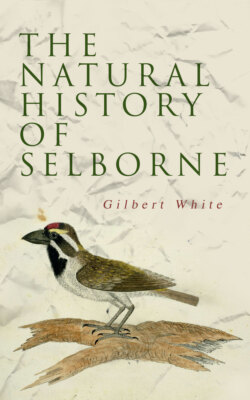Читать книгу The Natural History of Selborne - Gilbert White - Страница 10
На сайте Литреса книга снята с продажи.
LETTER V.
ОглавлениеTable of Contents
Among the singularities of this place the two rocky, hollow lanes, the one to Alton, and the other to the forest, deserve our attention. These roads, running through the malm lands, are, by the traffic of ages, and the fretting of water, worn down through the first stratum of our freestone, and partly through the second; so that they look more like water-courses than roads; and are bedded with naked rag for furlongs together. In many places they are reduced sixteen or eighteen feet beneath the level of the fields; and after floods, and in frosts, exhibit very grotesque and wild appearances, from the tangled roots that are twisted among the strata, and from the torrents rushing down their broken sides; and especially when those cascades are frozen into icicles, hanging in all the fanciful shapes of frost-work. These rugged, gloomy scenes affright the ladies when they peep down into them from the paths above, and make timid horsemen shudder while they ride along them; but delight the naturalist with their various botany, and particularly with their curious filices with which they abound.
The manor of Selborne, was it strictly looked after, with all its kindly aspects, and all its sloping coverts, would swarm with game; even now hares, partridges, and pheasants abound; and in old days woodcocks were as plentiful. There are few quails, because they more affect open fields than enclosures; after harvest some few landrails are seen.
The parish of Selborne, by taking in so much of the forest, is a vast district. Those who tread the bounds are employed part of three days in the business, and are of opinion that the outline, in all its curves and indentings, does not comprise less than thirty miles.
The village stands in a sheltered spot, secured by the Hanger from the strong westerly winds. The air is soft, but rather moist from the effluvia of so many trees; yet perfectly healthy and free from agues.
The quantity of rain that falls on it is very considerable, as may be supposed in so woody and mountainous a district. As my experience of measuring the water is but of short date, I am not qualified to give the mean quantity. I only know that
| Inch. | Hund. | |
| From May 1, 1779, to the end of the year, there fell | 28 | 37! |
| Jan. 1, 1780, to Jan. 1, 1781 | 27 | 32 |
| Jan. 1, 1781, to Jan. 1, 1782 | 30 | 71 |
| Jan. 1, 1782, to Jan. 1, 1783 | 50 | 26! |
| Jan. 1, 1783, to Jan. 1, 1784 | 33 | 71 |
| Jan. 1, 1784, to Jan. 1, 1785 | 33 | 80 |
| Jan. 1, 1785, to Jan. 1, 1786 | 31 | 55 |
| Jan. 1, 1786, to Jan. 1, 1787 | 39 | 57 |
The village of Selborne, and large hamlet of Oakhanger, with the single farms, and many scattered houses along the verge of the forest, contain upwards of six hundred and seventy inhabitants.
We abound with poor, many of whom are sober and industrious, and live comfortably in good stone or brick cottages, which are glazed, and have chambers above stairs; mud buildings we have none. Besides the employment from husbandry, the men work in hop-gardens, of which we have many, and fell and bark timber. In the spring and summer the women weed the corn, and enjoy a second harvest in September by hop-picking. Formerly, in the dead months they availed themselves greatly by spinning wool, for making of barragons, a genteel corded stuff, much in vogue at that time for summer wear, and chiefly manufactured at Alton, a neighbouring town, by some of the people called Quakers; but from circumstances this trade is at an end. The inhabitants enjoy a good share of health and longevity; and the parish swarms with children.
